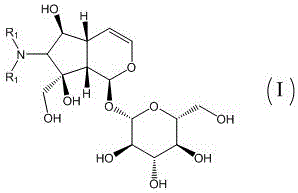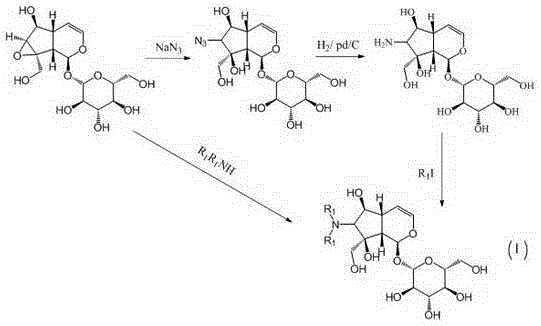Catalpol derivative as well as preparation method and application thereof
A derivative, the technology of catalpol, which is applied in the field of catalpol derivatives or their pharmaceutically acceptable salts and their preparation, can solve the problems of limited clinical application and unstable chemical properties
- Summary
- Abstract
- Description
- Claims
- Application Information
AI Technical Summary
Problems solved by technology
Method used
Image
Examples
Embodiment 1
[0030] Example 1: Compound I 1 Preparation
[0031] A 100ml dry three-necked flask is equipped with a stirrer and a thermometer. Catalpol (2.3g, 6.35mmol) and 46ml of dry anhydrous acetonitrile are added to it. With stirring, slowly add a methanol solution of dimethylamine (7ml, 8.56mmol), The temperature is raised to 45~50℃ and reacted for 6 hours. TLC identifies the end point of the reaction [thin layer development conditions (petroleum ether-ethyl acetate: methanol = 2:1:0.1)]. The reaction is complete. Concentrate to dryness under reduced pressure at <40°C, add acetone-methyl isopropyl ether to recrystallize the residue, filter, wash the solid with an appropriate amount of ether, and dry under vacuum at 35°C to 40°C for 6 hours to obtain 1.97 g of light yellow crystalline powdery solid The yield is 75.2%, and the HPLC content is 98.1%. HPLC method: use octadecylsilane bonded silica gel as filler, water-acetonitrile (99:1) as mobile phase, detection wavelength at 210nm, flow r...
Embodiment 2
[0038] Example 2: Compound I 1 Preparation of fumarate
[0039] 10ml three-necked flask, add I 1 Compound (0.8g, 1.96mmol) and 5ml of ethanol, add fumaric acid (0.29g, 2.5mmol) at room temperature, ultrasound for 10min, cool to -5℃~0℃ and let stand overnight, filter, and wash the solid with cold ethanol It was dried under vacuum at 35°C to 40°C to obtain 0.79 g of a pale yellow powdery solid with an HPLC content of 99.3%.
Embodiment 3
[0040] Example 3: Compound I 2 Preparation of fumarate
[0041] 1) 100ml dry three-necked flask, equipped with a stirrer and thermometer, add catalpol (2.3g, 6.35mmol) to it
[0042] And dry anhydrous acetonitrile 46ml and ammonium chloride (0.17g, 3.175mmol), under stirring, add sodium azide (0.46g, 7.1mmol), stir at room temperature for 24h, TLC identifies the end of the reaction [thin layer development conditions ( Petroleum ether-ethyl acetate: methanol=2:1:0.1)], after the reaction is complete, filter, filtrate Concentrate to dryness under reduced pressure at <40°C, add methyl ethyl ketone-methyl isopropyl ether to recrystallize the residue, filter, wash the solid with an appropriate amount of ether, and vacuum dry at 35°C to 40°C for 6 hours to obtain a pale yellow crystalline powdered solid 2.22 g, yield 86.3%, HPLC content 95.6%, directly used in the next step.
[0043] 2) The product from the previous step is added to 50ml of absolute ethanol, ferric chloride (1.48g, 5.48mm...
PUM
 Login to View More
Login to View More Abstract
Description
Claims
Application Information
 Login to View More
Login to View More - R&D
- Intellectual Property
- Life Sciences
- Materials
- Tech Scout
- Unparalleled Data Quality
- Higher Quality Content
- 60% Fewer Hallucinations
Browse by: Latest US Patents, China's latest patents, Technical Efficacy Thesaurus, Application Domain, Technology Topic, Popular Technical Reports.
© 2025 PatSnap. All rights reserved.Legal|Privacy policy|Modern Slavery Act Transparency Statement|Sitemap|About US| Contact US: help@patsnap.com



